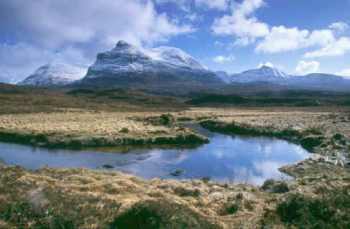|
MOUNTAIN & MOOR
Mountain
Many of the mountains on the western seaboard have a white cap of
quartzite rock overlaying red Torridonian sandstone. Very little grows on
the quartzite as it is hard and nutrient poor, and the climate is harsh.

Quinag
At high latitudes elsewhere, alpine and sub-alpine
heaths characterise the vegetation with dwarf shrubs such as alpine
bearberry, juniper, crowberry
and cowberry predominating with mountain sedges.
Slow growing mosses, lichens and liverworts become
dominant components in these communities, and rich communities of
liverworts inhabit the colder, wetter north-facing slopes. Golden eagle,
dotterel, ptarmigan, ring ouzel, mountain hare and deer inhabit these
mountain areas.
Seana Bhraigh, in the Parish of Kincardine and
Croick, holds an important montane flora which, in
botanical recording terms, is noted under Ross and Cromarty.
Limestone influenced vegetation occurs along the Moine Thrust in West
Sutherland, supporting a rich and distinctive plant community with
mountain avens as a dominant down to sea level such as at Durness. The
Inchnadamph National Nature Reserve, situated on the plateau between Loch
Assynt and Ben More Assynt, is of great botanical, geological and
geomorphological interest. The plantlife includes mountain avens,
globeflower, hollyfern and dark-red belleborine.
|
However, it is for its limestone caves, the largest
in Scotland, that Inchnadamph is better known. Excavations from caves
above the Allt Nan Uamh (Burn of the Caves) have revealed bones of the
animals that inhabited this part of Scotland around the time of the last
Ice Age. They include brown bear, polar bear, arctic fox, reindeer, lynx
and lemming. Smoo Cave is another impressive limestone cave at the head of
the narrow coastal inlet at Durness.
Upland calcareous grassland is generally restricted
to shallow soils over lime-rich rocks. Despite its name, it occurs down to
sea level in exposed conditions, and arctic-alpine plants can be present.
The most important type in nature conservation terms is the Mountain avens
variant, which occurs along the North Coast.
Moorland
The blanket bog of Caithness and Sutherland form a dramatic open landscape
with associated hills, lochs, rivers and small pools or dubh lochans.
These peatlands are home to a unique range of plants and animals, and the
plantlife is dominated by ling heather, cross-leaved heath, deer grass,
cotton grass and Sphagnum bog mosses. Rather than being important for
individual Sphagnum species, it is the diversity and abundance of bog
mosses in a relatively undisturbed state that makes the peatlands of
Caithness and Sutherland so significant in international terms. A rich and
varied invertebrate fauna provides a food source for the many bird species
that inhabit the peatlands. Red-throated and black-throated divers, wigeon,
common scoter, golden plover, greenshank, dunlin, wood sandpiper, greylag
goose, short-eared owl, golden eagle, hen harrier, merlin and peregrine
falcon can all be found here.
The knock-and-lochan landscape on the gneiss in the
West is characterised by rocky outcrops, small hills and lochans,
interspersed with small areas of blanket bog and oceanic - montane heath
dominated by heather, cross-leaved heath and deer grass. The wetter areas
have a greater proportion of bog mosses, and are home to waders such as
dunlin and
greenshank. Base-rich flushes with distinctive black
bog rush are common, along with more extensive
areas of species rich grassland including thyme and
lady’s mantle. |
